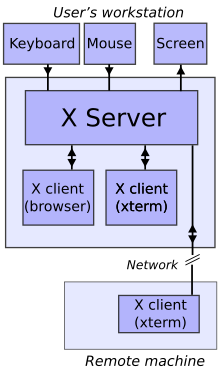Purpose and abilities

X is an architecture-independent system for remote graphical user interfaces and input device capabilities. Each person using a networked terminal has the ability to interact with the display with any type of user input device.
In its standard distribution it is a complete, albeit simple, display and interface solution which delivers a standard toolkit and protocol stack for building graphical user interfaces on most Unix-like operating systems and OpenVMS, and has been ported to many other contemporary general purpose operating systems.
X provides the basic framework, or primitives, for building such GUI environments: drawing and moving windows on the display and interacting with a mouse, keyboard or touchscreen. X does not mandate the user interface; individual client programs handle this. Programs may use X's graphical abilities with no user interface. As such, the visual styling of X-based environments varies greatly; different programs may present radically different interfaces.
Unlike most earlier display protocols, X was specifically designed to be used over network connections rather than on an integral or attached display device. X features network transparency, which means an X program running on a computer somewhere on a network (such as the Internet) can display its user interface on an X server running on some other computer on the network. The X server is typically the provider of graphics resources and keyboard/mouse events to X clients, meaning that the X server is usually running on the computer in front of a human user, while the X client applications run anywhere on the network and communicate with the user's computer to request the rendering of graphics content and receive events from input devices including keyboards and mice.
The fact that the term "server" is applied to the software in front of the user is often surprising to users accustomed to their programs being clients to services on remote computers. Here, rather than a remote database being the resource for a local app, the user's graphic display and input devices become resources made available by the local X server to both local and remotely hosted X client programs who need to share the user's graphics and input devices to communicate with the user.
X's network protocol is based on X command primitives. This approach allows both 2D and (through extensions like GLX) 3D operations by an X client application which might be running on a different computer to still be fully accelerated on the X server's display. For example, in classic OpenGL (before version 3.0), display lists containing large numbers of objects could be constructed and stored entirely in the X server by a remote X client program, and each then rendered by sending a single glCallList(which) across the network.
X provides no native support for audio; several projects exist to fill this niche, some also providing transparent network support.
Comments
Post a Comment